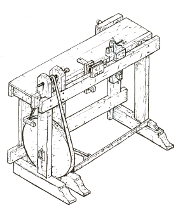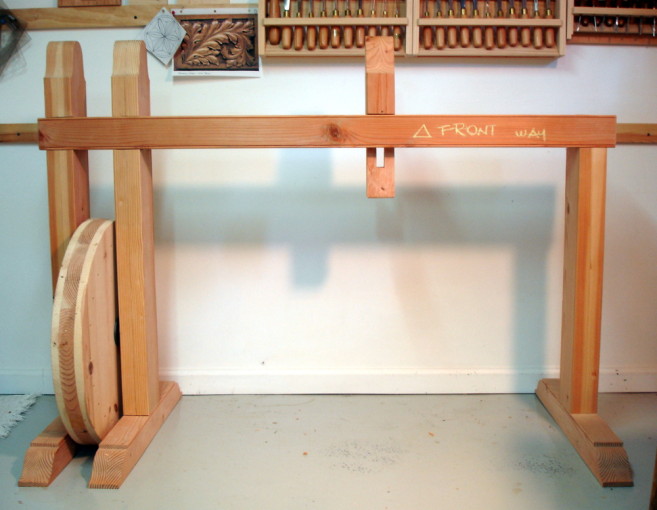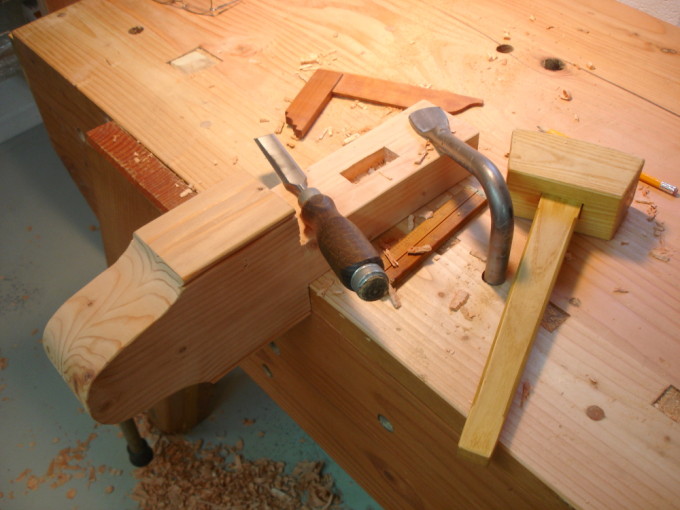 Building a treadle lathe started a long time ago, when the shop was too cold for epoxy to cure on a boat I was building. A lot of water has passed under our boats since then. Other activities, swimming, language learning, travel, and various forms of woodcarving have also happened. So, why back to the lathe now? Simple, some of the woodcarving I want to do is on various turned objects.
Building a treadle lathe started a long time ago, when the shop was too cold for epoxy to cure on a boat I was building. A lot of water has passed under our boats since then. Other activities, swimming, language learning, travel, and various forms of woodcarving have also happened. So, why back to the lathe now? Simple, some of the woodcarving I want to do is on various turned objects.
Quick recap: Plans are abundant. Making choices depends on intended use and can lead to analysis paralysis. My intended use does not include dragging the thing around to festivals, to shows, or any form of re-enactment. Out with the period costumes, and actually out with some of the other period authenticity.
The lathe is intended for practical use and I’ll certainly be using modern parts such as ball bearings, chucks and live centers.
My choice of structure most closely resembles Stephen Shepherd’s 1805 “Moses T” lathe, but without the bench behind the ways. Mine is also heavier in certain areas, mainly the uprights and feet.
The last we saw of the build had the bigger parts mostly complete, the uprights, feet, wheel and rough tail stock. All of it has been set aside in the shop and has shown no signs of checking, splitting, warping etc. Not bad for construction grade lumber. The photo of assembled parts is showing only a dry fit. Nothing is fastened to anything else. … and what looks like a piece of lumber much longer than the lathe is really a french cleat attached to the wall behind the lathe.
Recent work includes getting the tail stock to fit between the ways. That was basic tenon cutting. After that, I hacked out a through mortise that will later house a wedge.
Next up: A bevy of smaller parts for the treadle, or getting that wheel mounted between the uprights? hmmmmmm…


The lathe is looking good, I have those same plans and hope to make one similar to yours. I’ll decide on the bench or not later. After making a spring pole lathe at Roy’s school, which I can break down and use outside, this design seems like a more permanent option for my shop.
Nice work on the original structure.
But I fear that the treadle lathe is not going to work. The large drive wheel is not heavy enough to have enough strength to get on the rotation axis. The large drive wheel must weigh 35kg minimum for easy turning.
This weight is for a wheel diameter of 600mm.
Myself early this year a treadle lathe built, pictures can be found here: http://hout-en-boten.blogspot.com
Sorry for the poor English.
André
Hi Joe,
Yes, I’ve been following your blog. Sounds like a lot of fun learning at Roy’s school. Your lathe is looking great!
So, have you ordered a powdered wig and started sewing up blousy clothes? 🙂
Bob,
Glad to see you back at it on this lathe. I’m especially interested to see what you come up with to allow for the modern drive centers, chucks, etc. I did quite a bit of digging for female morse taper sleeves and haven’t had a lot of luck. My latest thought is to purchase a spare spindle directly from a powered lathe manufacturer. They can be had online for $40 or less in some cases and contain the morse sleeve as well as a threaded exterior that can accept a chuck. I may do the same thing on the tail stock too and grab a modern lathe part to set into my wooden puppet assembly. What are your plans?
Hi Shannon,
OK. You’re pushing me to reveal early some of the parts I’m saving for later.
Just for you, here’s a quick peek:
The headstock is simple. It will be a straight 5/8″ diameter spindle, essentially a proxy for a Shopsmith spindle. There are a couple of centers and adapters that fit directly on a 5/8″ spindle. A nice one is a 5/8″ to 1″x8tpi adapter. Once you get to 1″x8tpi, almost any chuck will fit.
For the tail stock, I hope to use a #2 “MT socket.” I found one that is 1″ outside diameter and about 4 inches long. It hasn’t yet arrived, so I can’t assure you that it’s a good answer.
I’ll have a lot more details about these parts, and how they are incorporated, as they arrive. I’ll be sure to include sources and part numbers.
Hallo André,
THANK YOU for the link to your blog and pictures. Your lathe is beautifully made! It looks much heavier than many of the others I have seen. The videos prove how well it works.
We will see about the weight of the wheel. It is now about 11kg. … Perhaps you are correct.
Do not apologize for your English. It works far better than my Dutch. Now, I must also learn Dutch to understand more about why you built the way you did. Or, as my youngest (Austrian) grandson said, “I need to learn English Monday.”
Just FYI, the links to “various turned objects” don’t work for me. It takes me to Mary’s sign up page. I suspect that only members who are signed in will be able to follow those links.
Thanks Theodore.
You’re right. Seeing those pages requires membership at Mary’s school. I’ll rework them.
Looking at this again Bob and I am really taken by the simplicity of the single vertical leg into foot approach. I keep falling back on the Williamsburg model design with the 45 degree brace thinking I will need that support. The trade off is the extra space that adds to the footprint. I think with the right stock like the timbers you are using that concerns can be eliminated. I may use my work connections and go with 6×6 timber in White Oak. Not because I need to but because I can. I have to take advantage of this day job at some point after all!
The savings on floor space is what drew me to this design, that and having the wheel between two bearings rather than cantilevered as in some designs.
The Shepherd drawings actually use 2×6 stock for the verticals. I doubled up more for aesthetics than strength.
Now, as long as you’re going to squeeze a discount out of your employer, why not curly maple instead of plain ole oak? 🙂
LOL, actually it will probably be curly Sapele. I think the wheel will easily break 100 lbs when it is done.